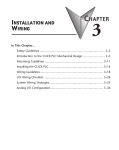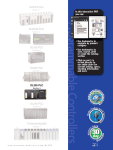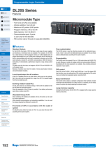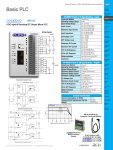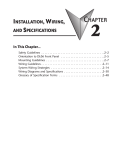Download Sharp 32L-S500 User manual
Transcript
INSTALLATION AND WIRING CHAPTER 5 In This Chapter... Safety Guidelines . . . . . . . . . . . . . . . . . . . . . . . . . . . . . . . . . . . . . . . . . . . . . . . . . . .5–2 Introduction to the Productivity3000 Mechanical Design . . . . . . . . . . . . . . . . . . .5–5 Dimensions and Installation . . . . . . . . . . . . . . . . . . . . . . . . . . . . . . . . . . . . . . . . . . .5–6 Mounting Guidelines . . . . . . . . . . . . . . . . . . . . . . . . . . . . . . . . . . . . . . . . . . . . . . . .5–7 Wiring Guidelines . . . . . . . . . . . . . . . . . . . . . . . . . . . . . . . . . . . . . . . . . . . . . . . . . .5–14 I/O Module Wiring Options . . . . . . . . . . . . . . . . . . . . . . . . . . . . . . . . . . . . . . . . . .5–16 System Wiring Strategies . . . . . . . . . . . . . . . . . . . . . . . . . . . . . . . . . . . . . . . . . . . .5–20 Chapter 5: Installation and Wiring Safety Guidelines A1 2 3 4 5 6 7 8 9 10 11 12 14 14 A B C D NOTE: Products with CE marks perform their required functions safely and adhere to relevant standards as specified by CE directives provided they are used according to their intended purpose and that the instructions in this manual are adhered to. The protection provided by the equipment may be impaired if this equipment is used in a manner not specified in this manual. A listing of our international affiliates is available on our Web site at http://www.automationdirect.com. WARNING: Providing a safe operating environment for personnel and equipment is your responsibility and should be your primary goal during system planning and installation. Automation systems can fail and may result in situations that can cause serious injury to personnel or damage to equipment. Do not rely on the automation system alone to provide a safe operating environment. You should use external electromechanical devices, such as relays or limit switches, that are independent of the PAC application to provide protection for any part of the system that may cause personal injury or damage. Every automation application is different, so there may be special requirements for your particular application. Make sure you follow all national, state, and local government requirements for the proper installation and use of your equipment. Plan for Safety The best way to provide a safe operating environment is to make personnel and equipment safety part of the planning process. You should examine every aspect of the system to determine which areas are critical to operator or machine safety. If you are not familiar with PAC system installation practices, or your company does not have established installation guidelines, you should obtain additional information from the following sources. • NEMA — The National Electrical Manufacturers Association, located in Washington, D.C., publishes many different documents that discuss standards for industrial control systems. You can order these publications directly from NEMA. Some of these include: ICS 1, General Standards for Industrial Control and Systems ICS 3, Industrial Systems ICS 6, Enclosures for Industrial Control Systems • NEC — The National Electrical Code provides regulations concerning the installation and use of various types of electrical equipment. Copies of the NEC Handbook can often be obtained from your local electrical equipment distributor or your local library. • Local and State Agencies — many local governments and state governments have additional requirements above and beyond those described in the NEC Handbook. Check with your local Electrical Inspector or Fire Marshall office for information. 5–2 Hardware User Manual, 4th Edition, Rev. B Chapter 5: Installation and Wiring Three Levels of Protection WARNING: The control program must not be the only form of protection for any problems that may result in a risk of personal injury or equipment damage. The publications mentioned provide many ideas and requirements for system safety. At a minimum, you should follow these regulations. Also, you should use the following techniques, which provide three levels of system control. 1. Orderly system shutdown sequence in the PAC control program. Jam Detect Turn off Saw RST 2. Mechanical disconnect for output module power. 3. Emergency stop switch for disconnecting system power. RST Retract Arm Orderly System Shutdown The first level of fault detection is ideally the PAC control program, which can identify machine problems. Certain shutdown sequences should be performed. These types of problems are usually things such as jammed parts, etc. that do not pose a risk of personal injury or equipment damage. System Power Disconnect You should also use electromechanical devices, such as master control relays and/or limit switches, to prevent accidental equipment startup at an unexpected time. These devices should be installed in a manner that will prevent any machine operations from occurring. For example, if the machine in the illustration has a jammed part, the PAC control program can turn off the saw blade and retract the arbor. If the operator must open the guard to remove the part, you should also include a bypass switch that disconnects all system power any time the guard is opened. Hardware User Manual, 4th Edition, Rev. B 5–3 A 2 3 4 5 3 3 3 3 3 3 3 3 3 3 3 3 3 Chapter 5: Installation and Wiring Emergency Stop Circuits Emergency stop (E-Stop) circuits are a critical part of automation safety. For each machine controlled by a PAC, provide an emergency stop device that is wired outside the PAC and easily accessed by the machine operator. E-stop devices are commonly wired through a master control relay (MCR) or a safety control relay (SCR) that will remove power from the PAC I/O system in an emergency. MCRs and SCRs provide a convenient means for removing power from the I/O system during an emergency situation. By de-energizing an MCR (or SCR) coil, power to the input (optional) and output devices is removed. This event occurs when any emergency stop switch opens. However, the PAC continues to receive power and operate even though all its inputs and outputs are disabled. The MCR circuit could be extended by placing a PAC fault relay (closed during normal PAC operation) in series with any other emergency stop conditions. This would cause the MCR circuit to drop the PAC I/O power in case of a PAC failure (memory error, I/O communications error, etc.). A 2 3 4 5 3 3 3 3 3 3 3 3 3 3 3 3 3 ENCY EMERG STOP Guard Limit Switch L1 N Use E-Stop and Master Maste Control Relay E-Stop Power On Limit S Switch Master Control Relay (MCR) MCR MCR MCR CR1 CR1 Saw Arbor WARNING: For some applications, field device power may still be present on the terminal block even though the PAC is turned off. To minimize the risk of electrical shock, remove all field device power before you expose or remove PAC wiring. 5–4 Hardware User Manual, 4th Edition, Rev. B Chapter 5: Installation and Wiring Introduction to the Productivity3000 Mechanical Design The Productivity3000 is a modular system that requires a base to accommodate the various modules. Bases are available with 3, 5, 8 and 11 I/O module slots. The bases contain additional dedicated slots for the power supply and the CPU. You can place any I/O module in any I/O slot without power budget or module type restrictions. Each Productivity3000 system requires one CPU module mounted in the controller slot in the first base of the local base group. The system can be expanded with the P3-RS, P3-RX or P3-EX modules. Typical Productivity3000 System Base Mounting Tab Base I/O Module (Output) DIN Rail Mounting Slot I/O Module (Input) Power Supply CPU ZIPLinks Wiring System Hardware User Manual, 4th Edition, Rev. B 5–5 A 2 3 4 5 3 3 3 3 3 3 3 3 3 3 3 3 3 Chapter 5: Installation and Wiring Dimensions and Installation A 2 3 4 5 3 3 3 3 3 3 3 3 3 3 3 3 3 Before installing the PAC system you will need to know the dimensions of the components considered. These diagrams provide the base dimensions to use in defining your enclosure specifications. Remember to leave room for potential expansion. If you are using other components in your system, refer to the appropriate manual to determine how those units can affect mounting dimensions. The height dimension is the same for all bases. The depth varies depending on your choice of I/O module. The Productivity3000 is designed to be mounted on standard 35mm DIN rail, or it can be surface mounted. Make sure you have followed the installation guidelines for proper spacing. Base Dimensions 8.50 [215.9] 4.75 [120.7] P3-03B P3-03B P3-03B 5.59 [142.1] 6.00 [152.4] 7.56 [192.0] 11.25 [285.6] P3-05B P3-05B P3-05B 5.59 [142.1] 6.00 [152.4] inches [mm] 10.31 [261.9] 15.44 [392.2] P3-08B P3-08B P3-08B 5.59 [142.1] 6.00 [152.4] 14.50 [368.3] 19.56 [496.8] P3-11B P3-11B P3-11B 5.59 [142.1] 6.00 [152.4] 9.88 [251.0] 5–6 8.75 [222.3] Hardware User Manual, 4th Edition, Rev. B Chapter 5: Installation and Wiring Mounting Guidelines Enclosures Your selection of a proper enclosure is important to ensure safe and proper operation of your Productivity3000 system. Applications for the Productivity3000 system vary and may require additional hardware considerations. The minimum considerations for enclosures include: • Conformance to electrical standards • Protection from the elements in an industrial environment • Common ground reference • Maintenance of specified ambient temperature • Access to the equipment • Security or restricted access • Sufficient space for proper installation and maintenance of the equipment Mounting Position Mount the bases horizontally, as shown in the illustration on the following page, to provide proper ventilation. Do not mount the bases vertically, upside down, or on a flat horizontal surface. Mounting Clearances Provide a minimum clearance of 2 inches (50mm) between the bases and all sides of the enclosure. Allow extra door clearance for operator panels and other door mounted items. There should be a minimum of 3 inches (76mm) clearance between the base and any wire duct, and a minimum of 7.2 inches (183mm) from base to base in a multiple base installation. Grounding A good common ground reference (earth ground) is essential for proper operation of the Productivity3000 system. One side of all control circuits, power circuits and the ground lead must be properly connected to earth ground by either installing a ground rod in close proximity to the enclosure or by connecting to the incoming power system ground. There must be a single-point ground (i.e. copper bus bar) for all devices in the enclosure that require an earth ground. Temperature Considerations The Productivity3000 system should be installed within the operating temperature specifications. If the temperature deviates above or below the specification, measures such as cooling or heating the enclosure should be taken to maintain the specification. Power Considerations The Productivity3000 system is designed to be powered by 110/240 VAC or 24/48 VDC via one of the Productivity3000 power supplies. The Productivity3000 has achieved CE certification without requiring EMF/RFI line noise filters on the AC power supply. Please review the European Union (CE) appendix for more information. Hardware User Manual, 4th Edition, Rev. B 5–7 A 2 3 4 5 3 3 3 3 3 3 3 3 3 3 3 3 3 Chapter 5: Installation and Wiring A 2 3 4 5 3 3 3 3 3 3 3 3 3 3 3 3 3 2” 50mm min 2” 50mm min 3” 76mm min 7 7.2” 2” 183mm min 3” 76mm min 2” 50mm min Ground Braid Copper Lugs Panel or Single Point Ground OK Panel Star Washers Star Washers AIRFLOW 3” [76mm] NOTE: Add 3 inches (76 mm) to mounting depth when using ZIPLink cable ZL-CBL40. 5–8 Hardware User Manual, 4th Edition, Rev. B Chapter 5: Installation and Wiring In addition to the panel layout guidelines, other specifications can affect the installation of a PAC system. Always consider the following: • Environmental Specifications • Power Requirements • Agency Approvals • Enclosure Selection and Component Dimensions Class 1, Division 2 Approval This equipment is suitable for use in Class 1, Division 2, Zone 2, groups A, B, C and D or non–hazardous locations only. WARNING: Explosion Hazard: Substitution of components may impair suitability for Class 1, Division 2, Zone 2. Do not disconnect equipment unless power has been switched off or the area is known to be non–hazardous. Agency Approvals Some applications require agency approvals for particular components. The Productivity3000 PAC agency approvals are listed below: • UL (Underwriters’ Laboratories, Inc.) • CUL (Canadian Underwriters’ Laboratories, Inc.) • CE (European Economic Union) NOTE: See the “EU Directive” appendix in this manual for more information. Hardware User Manual, 4th Edition, Rev. B 5–9 A 2 3 4 5 3 3 3 3 3 3 3 3 3 3 3 3 3 Chapter 5: Installation and Wiring Using Mounting Rails The Productivity3000 bases can be secured to the cabinet using mounting rails. You should use rails that conform to DIN EN standard 50 022. We offer a complete line of DIN rail, DINnectors and DIN rail mounted apparatus. These rails are approximately 35mm high, with a depth of 7.5mm. If you mount the base on a rail, you should also consider using end brackets on each side of the base. The end brackets help keep the base from sliding horizontally along the rail. This helps minimize the possibility of accidentally pulling the wiring loose. If you examine the bottom of the base, you'll notice retaining clips. To secure the base to a DIN rail, place the base onto the rail and gently push up on the retaining clips. The clips lock the base onto the rail. To remove the base, pull down on the retaining clips, slightly lift up the base, and pull it away from the rail. A 2 3 4 5 3 3 3 3 3 3 3 3 3 3 3 3 3 End Bracket (Part No. DN-EB35) DIN Rail Dimensions 7.5 mm 35 mm DIN Rail (Part No. DN-R35S1) 1 Hook base onto DIN rail at top of mounting slot. 2 Rotate base into position. 3 Gently push up retaining clips. Retaining Clips 5–10 Hardware User Manual, 4th Edition, Rev. B Chapter 5: Installation and Wiring Installing the Power Supply A 2 3 4 5 3 3 3 3 3 3 3 3 3 3 3 3 3 Step One: Locate the left most socket in the base. Step Two: Insert the Power Supply at a 45° angle into the notch located at the top of the base and rotate down until seated in socket. Step Three: Snap the two retaining tabs into the locked position. WARNING: Explosion hazard – Do not connect or disconnect connectors or operate switches while circuit is live unless the area is known to be non-hazardous. Do not hot swap. Hardware User Manual, 4th Edition, Rev. B 5–11 Chapter 5: Installation and Wiring Installing the CPU This installation procedure also applies to the P3-EX expansion module and the P3-RS/P3-RX remote slave modules. A 2 3 4 5 3 3 3 3 3 3 3 3 3 3 3 3 3 Step One: Locate the two sockets next to the power supply; the CPU will be inserted into this location. Step Two: Insert the CPU at a 45° angle into the notch located at the top of the base and rotate down until seated. Step Three: Snap retaining tab into the locked position. WARNING: Explosion hazard – Do not connect or disconnect connectors or operate switches while circuit is live unless the area is known to be non-hazardous. Do not hot swap. 5–12 Hardware User Manual, 4th Edition, Rev. B Chapter 5: Installation and Wiring Installing the I/O Modules WARNING: Do not apply field power until the Align here following steps are completed. See hotswapping procedure for exceptions. Step One: Align circuit card with slot and press firmly to seat module into connector. Step Two: Pull top and Align here bottom locking tabs toward module face. Click indicates lock is engaged. Step Three: Attach field wiring using optional terminal block or ZIPLink wiring system and install cover. To install or remove terminal block cover, press middle to flex cover. WARNING: Explosion hazard – Do not connect or disconnect connectors or operate switches while circuit is live unless the area is known to be non-hazardous. Do not hot-swap modules unless the area is known to be non-hazardous. WARNING: The Productivity3000 PAC supports Hot Swap. Individual modules, expansion bases, and entire remote base groups can be taken offline, removed, and replaced while the rest of the PAC system continues controlling your process. Hot Swapping is performed with a HOT (powered) system. EXTREME care must be taken to prevent damage to components, terminal blocks, or even personal injury due to a short circuit from the live terminal block. Before attempting to use the hot swap feature, be sure to read the hot swap topic in the ProductivitySuite Help file for details on how to plan your installation for use of this powerful feature. Hardware User Manual, 4th Edition, Rev. B 5–13 A 2 3 4 5 3 3 3 3 3 3 3 3 3 3 3 3 3 Chapter 5: Installation and Wiring Wiring Guidelines A 2 3 4 5 3 3 3 3 3 3 3 3 3 3 3 3 3 Wiring to the Power Supply Connect the AC or DC power source input wiring to the power supply as shown. The power supply terminals can accept up to 14 AWG solid or stranded wire. Do not overtighten the terminal screws; the recommended torque is 7 to 9 inch-pounds (0.882 to 1.02 Nm). WARNING: Once the power wiring is connected, secure the terminal block cover in the closed position. When the cover is open there is a risk of electrical shock if you accidentally touch the connection terminals or power wiring. Grounding A good common ground reference (earth ground) is essential for proper operation of the Productivity3000 system. One side of all control circuits, power circuits and the ground lead must be properly connected to earth ground by either installing a ground rod in close proximity to the enclosure or by connecting to the incoming power system ground. There must be a single-point ground (i.e. copper bus bar) for all devices in the enclosure that require an earth ground. P3-01AC 5–14 P3-01DC ACL +V ACN -V GND GND LOGIC GND LOGIC GND Hardware User Manual, 4th Edition, Rev. B Chapter 5: Installation and Wiring Fuse Protection Some of the Input and Output I/O module circuits do not have internal fuses. In order to protect your modules, we suggest you add external fuses to your I/O wiring. A fast-blow fuse with a lower current rating than the I/O bank’s common current rating can be wired to each common. Or, a fuse with a rating of slightly less than the maximum current per output point can be added to each output. Refer to the I/O module specifications in Chapter 2 to find the maximum current per output point or per output common. Adding the external fuse does not guarantee the prevention of PAC damage, but it will provide added protection. Hardware User Manual, 4th Edition, Rev. B 5–15 A 2 3 4 5 3 3 3 3 3 3 3 3 3 3 3 3 3 Chapter 5: Installation and Wiring I/O Module Wiring Options A 2 3 4 5 3 3 3 3 3 3 3 3 3 3 3 3 3 There are two available methods for wiring most I/O modules: The ZIPLink wiring system or hand wiring to the optional removable I/O module terminal blocks. NOTE: The high-density 32-point and 64-point I/O module design requires the use of the ZIPLink wiring system. Thermocouple and RTD modules are not compatible with the ZIPLink system and are shipped with the terminal blocks included. ZIPLink Wiring System The ZIPLink wiring system is the recommended method, which allows quick and easy connection using cables that are prewired to the I/O module terminal blocks at one end and plug into a ZIPLink connector module terminal block at the other end. Use the tables on the following page to specify your ZIPLink wiring system. ZIPLink Wiring System Sample ZIPLink Module ZIPLink Pre-Wired Terminal Block Cable Terminal Block With Pigtail Cable For most I/O modules you can also purchase ZIPLink pigtail cables. ZIPLink Pigtail Cable 5–16 Hardware User Manual, 4th Edition, Edition Rev. B Chapter 5: Installation and Wiring Productivity3000 Input Module ZIPLink Selector ZIPLink PLC Input # of Module Module Terms Component Part No. Productivity3000 Output Module ZIPLink Selector ZIPLink PLC Cable Part No. Output Module # of Module Terms Component Part No. Cable Part No. P3-08NAS 20 Feedthrough ZL-RTB20 ZL-P3-CBL20* P3-08TAS 20 Feedthrough ZL-RTB20 ZL-P3-CBL20* P3-08ND3S 20 Feedthrough ZL-RTB20 ZL-P3-CBL20* P3-08TD1S 20 Feedthrough ZL-RTB20 ZL-P3-CBL20-*L P3-16NA 20 Feedthrough Feedthrough Sensor Feedthrough ZL-RTB20 ZL-RTB20 ZL-LTB16-24 ZL-RTB40 ZL-P3-CBL20-*L ZL-P3-CBL20-*L ZL-P3-CBL20-*L ZL-CBL40* P3-08TD2S 20 Feedthrough ZL-RTB20 ZL-P3-CBL20-*L P3-08TRS 20 Feedthrough ZL-RTB20 ZL-P3-CBL20* P3-16TA 20 Feedthrough ZL-RTB20 ZL-P3-CBL20* ZL-CBL40* Fuse ZL-RFU20 ZL-P3-CBL20* ZL-CBL40* ZL-CBL40* Feedthrough ZL-RTB20 ZL-P3-CBL20* Fuse ZL-RFU204 ZL-P3-CBL20* P3-16ND3 20 P3-32ND3 40 P3-64ND31 Sensor Feedthrough Sensor 40 ZL-LTB32-24 ZL-RTB40 ZL-LTB32-24 Productivity3000 Analog In Module ZIPLink Selector ZIPLink PLC Analog Module # of Terms P3-16TD1 20 Relay (sinking) ZL-RRL16-24-1 ZL-P3-CBL20* P3-16TD2 20 Feedthrough ZL-RTB20 ZL-P3-CBL20* Fuse ZL-RFU204 ZL-P3-CBL20* Relay (sourcing) ZL-RRL16-24-2 ZL-P3-CBL20 Component Module Cable P3-16TR 20 Feedthrough ZL-RTB20 ZL-P3-CBL20* ZL-P3-CBL20* P3-04ADS 20 Feedthrough ZL-RTB20 ZL-P3-CBL20-*L Fuse ZL-RFU204 P3-08AD 20 Feedthrough ZL-RTB20 ZL-P3-CBL20-*L Feedthrough ZL-RTB20 ZL-P3-CBL20* Feedthrough Feedthrough ZL-RTB20 ZL-P3-CBL20-*L ZL-RTB20 ZL-P3-CBL20-*L Fuse ZL-RFU204 ZL-P3-CBL20* Feedthrough ZL-RTB40 ZL-CBL40* Fuse ZL-RFU404 ZL-CBL40* Feedthrough ZL-RTB40 ZL-CBL40* P3-04DA P3-08DA-1 20 20 Matched Only T/C Wire Only 20 20 Feedthrough Feedthrough ZL-RTB20 ZL-P3-CBL20-*L ZL-RTB20 ZL-P3-CBL20-*L Fuse ZL-RFU404 ZL-CBL40* Feedthrough ZL-RTB40 ZL-CBL40* P3-08DA-2 20 Feedthrough ZL-RTB20 ZL-P3-CBL20-*L P3-06DAS-1 20 Feedthrough ZL-RTB20 ZL-P3-CBL20-*L P3-06DAS-2 20 Feedthrough ZL-RTB20 ZL-P3-CBL20-*L P3-16DA-1 20 Feedthrough ZL-RTB20 ZL-P3-CBL20-*L Fuse Feedthrough Fuse Feedthrough ZL-RFU404 ZL-CBL40* ZL-CBL40* ZL-CBL40* ZL-CBL40* P3-16AD-1 P3-16AD-2 P3-08RTD2 P3-08THM2 P3-08TRS-13 P3-32TD1 See Note 2 20 40 See Note 2 P3-16DA-2 20 Feedthrough ZL-RTB20 ZL-P3-CBL20-*L P3-8AD4DA-1 20 Feedthrough ZL-RTB20 ZL-P3-CBL20-*L P3-8AD4DA-2 20 Feedthrough ZL-RTB20 ZL-P3-CBL20-*L Productivity3000 Specialty Module ZIPLink Selector ZIPLink PLC Input # of Module Module Terms Component Part No. Cable Part No. P3-HSI 40 Feedthrough ZL-RTB40 ZL-CBL40*S P3-HSO 40 Feedthrough ZL-RTB40 ZL-CBL40*S P3-32TD2 P3-64TD11 40 40 P3-64TD21 40 P3-16TD3P 40 ZL-RTB40 ZL-RFU404 ZL-RTB40 * Select the cable length by replacing the * with: Blank = 0.5m, -1 = 1.0m, or -2 = 2.0m. 1 The P3-64ND3, P3-64TD1 and P3-64TD2 modules have two 32-point connectors and require two ZIPLink cables and two ZIPLink connector modules. 2 These modules are not supported by the ZIPLink wiring system. 3 The P3-08TRS-1 output module is derated not to exceed 2A per point maxiumum when used with the ZIPLink wiring system. 4 Note: Fuses (5 x 20 mm) are not included. See Edison Electronic Fuse section for (5 x 20 mm) fuse. S500 and GMA electronic circuit protection for fast-acting maximum protection. S506 and GMC electronic circuit protection for time-delay performance. Ideal for inductive circuits. To ensure proper operation, do not exceed the voltage and current rating of ZIPLink module. ZL-RFU20 = 2A per circuit; ZL-RFU40 = 400 mA per circuit. Hardware User Manual, 4th Edition, Rev. B 5–17 A 2 3 4 5 3 3 3 3 3 3 3 3 3 3 3 3 3 Chapter 5: Installation and Wiring Removable Terminal Blocks (Optional) The hand wiring method consists of purchasing the optional removable I/O module terminal block (part no. P3-RTB) and hand wiring from the I/O terminal block to a DIN rail mounted terminal block. A 2 3 4 5 3 3 3 3 3 3 3 3 3 3 3 3 3 Removable Terminal Block P3-RTB Terminal Block Removal 2. Loosen selfjacking screws to disengage terminal block. 3. Grip opened door along edge to avoid flexing door and pull terminal block from module. 1. Pull hinged door open here. NOTE: Do not grip door in middle. Removable Terminal Block Specifications Number of Positions Wire Range Screw Driver Width Screw Size Screw Torque 5–18 20 screw terminals 22-14 AWG (0.324 to 2.08 sq. mm) Solid / stranded conductor 3/64 in. (1.2 mm) insulation maximum "USE COPPER CONDUCTORS , 60°C" or equivalent. 1/4 inch (6.5 mm) maximum M3 size Field terminals – 7 - 9 in./lb (0.882 - 1.02 Nm) Self-jacking screws – 2.7 - 3.6 in./lb (0.3 - 0.4 Nm) Do not overtighten screws when installing terminal block. Hardware User Manual, 4th Edition, Rev. B Chapter 5: Installation and Wiring Planning the I/O Wiring Routes The following guidelines provide general information on how to wire the I/O connections to Productivity3000 PAC's. For specific information on wiring a particular I/O module refer to the module specifications in Chapter 2. 1. If using removable terminal blocks, follow the wire size guidelines in the I/O modules specifications in Chapter 2. 2. Always use a continuous length of wire. Do not splice wires to attain a needed length. 3. Use the shortest possible wire length. 4. Use wire trays for routing where possible. 5. Avoid running wires near high energy wiring. 6. Avoid running input wiring close to output wiring where possible. 7. To minimize voltage drops when wires must run a long distance , consider using multiple wires for the return line. 8. Avoid running DC wiring in close proximity to AC wiring where possible. 9. Avoid creating sharp bends in the wires. 10. When using P3-01DC power supplies, install the recommended powerline filter to reduce power surges and EMI/RFI noise. Hardware User Manual, 4th Edition, Rev. B 5–19 A 2 3 4 5 3 3 3 3 3 3 3 3 3 3 3 3 3 Chapter 5: Installation and Wiring System Wiring Strategies A 2 3 4 5 3 3 3 3 3 3 3 3 3 3 3 3 3 The Productivity3000 system is very flexible and will work in many different wiring configurations. By studying this section before actual installation, you can find the best wiring strategy for your application. This will help to lower system cost and wiring errors, and avoid safety problems. PAC Isolation Boundaries PAC circuitry is divided into three main regions separated by isolation boundaries, shown in the drawing below. Electrical isolation provides safety, so that a fault in one area does not damage another. The transformer in the power supply provides magnetic isolation between the primary and secondary sides. Optical isolators provide isolation in Input and Output circuits. This isolates logic circuitry from the field side, where factory machinery connects. The discrete inputs are isolated from the discrete outputs because each is isolated from the logic side. Isolation boundaries protect the devices which are connected to the communication ports, such as PCs and HMIs, from power input faults or field wiring faults. When wiring a PAC, it is extremely important to avoid making external connections that connect logic side circuits to any other. PC, HMI, or other communication devices Power Supply CPU Module Input Module Output Module Logic Circuit Logic Circuit Input Circuit Output Circuit Power Input Filter Optional Logic Circuit Com Ports Isolation Boundary 5–20 Hardware User Manual, 4th Edition, Rev. B Chapter 5: Installation and Wiring Sinking/Sourcing Concepts Before wiring field devices to the PAC I/O, it’s necessary to have a basic understanding of “sinking” and “sourcing” concepts. Use of these terms occurs frequently in input or output circuit discussions. The purpose of this section is to explain the terms. The short definitions are as follows: Sinking = Path to supply ground (–) or switching ground Sourcing = Path to supply source (+) or switching +V + – These terms only apply to DC circuits, not AC circuits. Input and output points that are either sinking or sourcing can conduct current in only one direction. This means it is possible to wire the external supply and field device to the I/O point with current trying to flow in the wrong direction, in which case the circuit will not operate. PAC The diagram on the left shows a “sinking” PAC input. To Input properly connect the external supply, connect it so that (sinking) the input provides a path to ground (–). Start at the PAC input terminal, follow through the input sensing circuit, Input Sensing exit at the common terminal, and connect the supply (–) to the common terminal. Common The switch between the supply (+) and the input completes the circuit. Current flows in the direction of the arrow when the switch is closed. By applying the circuit principle above to the four possible combinations of input/output sinking/sourcing types, we have the four circuits as shown below. Sinking Input Sinking Output Input PAC PAC Output Load + – + Common Input Sensing Sourcing Input – Common Sourcing Output Common + – Output Switch Input PAC Input Sensing PAC Common + Output Switch Output – Load Hardware User Manual, 4th Edition, Rev. B 5–21 A 2 3 4 5 3 3 3 3 3 3 3 3 3 3 3 3 3 Chapter 5: Installation and Wiring I/O “Common Terminal” Concepts A 2 3 4 5 3 3 3 3 3 3 3 3 3 3 3 3 3 In order for a PAC I/O circuit to operate, current must enter at one terminal and exit at another. This means at least two terminals are associated with every I/O point. In the figure below, the input or output terminal is the main path for the current. One additional terminal must provide the return path to the power supply. If there was unlimited module space then every I/O point could have two dedicated terminals as the figure above shows. Providing this level of flexibility is not practical or necessary for most applications. So, most I/O point groups share the return path (common) among two or more I/O points. The figure below shows a group (or bank) of four input points which share a common return path. In this way, the four inputs require only five terminals instead of eight. PAC Field Device Main Path (I/O point) I/O Circuit + – Return Path PAC Input Sensing Input 1 Input 2 Input 3 Input 4 + – Common Electrical Common To All Input Points NOTE: In the circuit above, the current in the common path is equal to the sum of the energized channels. This is especially important in output circuits, where larger gauge wire is sometimes needed for the commons. 5–22 Hardware User Manual, 4th Edition, Rev. B Chapter 5: Installation and Wiring DC Input Wiring Methods I/O modules with DC inputs can be wired as either sinking or sourcing inputs. The dual diodes (shown in this diagram) allow current to flow in either direction. Inputs grouped by a common point must be either all sinking or all sourcing. DC inputs typically operate in the range of +12-24 VDC. PAC DC Input Input Common Sinking Input Sensor (NPN Type) to PAC Sourcing Input In the following example, a field device has an open-collector NPN transistor output. When energized, it sinks current to ground from the DC input point. The PAC input current is sourced from the common terminal connected to power supply (+). Field Device PAC DC Input Input (sourcing) Output (sinking) DC NPN Sensor (Sinking) PAC Input (Sourcing) Supply – Ground + Common Sourcing Input Sensor (PNP Type) to PAC Sinking Input In the following example, a field device has an open-emitter PNP transistor output. When energized, it sources current to the PAC input point, which sinks the current to ground. Since the field device loop is sourcing current, no additional power supply is required for the module. Field Device DC PNP Sensor (Sourcing) PAC DC Input Input (sinking) PAC Input (Sinking) Output (sourcing) Ground Common DC Output Wiring Methods I/O modules with DC output circuits are wired as all current sinking only or current sourcing only depending on which output module part number is used. DC outputs typically operate in the range of +5-24 VDC. PAC Sinking Output to Sourcing Load Device Many applications require connecting a PAC output point to a DC input on a field device load. This type of connection is made to carry a low-level DC signals. In the following example, the PAC output point sinks current to ground (common) when energized. The output is connected to a field device load with a sourcing input. PAC DC Output +DC Power PAC Output (Sinking) Field Device Power Output (sinking) Input (sourcing) + DC Load (Sourcing) 20-28 VDC Common – Ground Hardware User Manual, 4th Edition, Rev. B 5–23 A 2 3 4 5 3 3 3 3 3 3 3 3 3 3 3 3 3 Chapter 5: Installation and Wiring PAC DC Sinking Output to Sinking Load Device In the example below, a sinking output point is connected to the sinking input of a field device load. In this case, both the PAC output and field device input are sinking type. Since the circuit must have one sourcing and one sinking device, we add sourcing capability to the PAC output by using a pull-up resistor. In the circuit below, we connect Rpull-up from the output to the DC output circuit power input. A 2 3 4 5 3 3 3 3 3 3 3 3 3 3 3 3 3 PAC DC Output PAC Output (Sinking with Pull-up Resistor) DC NPN Load (Sinking) Power +DC pwr Field Device R pull-up (sourcing) (sinking) Output + Input (sinking) – Ground R input Supply Common NOTE: DO NOT attempt to drive a heavy load (>25 mA) with this pull-up method. NOTE: Using the pull-up resistor to implement a sourcing output has the effect of inverting the output point logic. In other words, the field device input is energized when the PAC output is OFF, from a ladder logic point-of-view. Your ladder program must comprehend this and generate an inverted output. Or, you may choose to cancel the effect of the inversion elsewhere, such as in the field device. It is important to choose the correct value of Rpull-up. In order to do so, we need to know the nominal input current to the field device (Iinput) when the input is energized. If this value is not known, it can be calculated as shown (a typical value is 15 mA). Then use Iinput and the voltage of the external supply to compute Rpull-up. Then calculate the power Ppull-up (in watts), in order to size Rpull-up properly. I input V = R input R pull-up = P 5–24 pull-up input (turn–on) = V supply – 0.7 I – R input input V supply 2 R pull-up Hardware User Manual, 4th Edition, Rev. B Chapter 5: Installation and Wiring Relay Outputs - Wiring Methods Relay outputs are available for the Productivity3000. Relays are best for the following applications: • Loads that require higher currents than the solid-state outputs can deliver • Cost-sensitive applications • Some output channels need isolation from other outputs (such as when some loads require different voltages than other loads) Some applications in which NOT to use relays: • Loads that require currents under 10 mA • Loads which must be switched at high speed or heavy duty cycle Relay with Form A contacts Relay with Form C contacts Relay outputs are available in two contact arrangements. Form A type, or SPST (single pole, single throw) type. They are normally open and are the simplest to use. The Form C, or SPDT (single pole, double throw) type has a center contact which moves and a stationary contact on either side. This provides a normally closed contact and a normally open contact. The relays in some relay output modules share common terminals, which connect to the wiper contact in each relay of the bank. Other relay modules have relays which are completely isolated from each other. In all cases, the module drives the relay coil when the corresponding output point is on. Hardware User Manual, 4th Edition, Rev. B 5–25 A 2 3 4 5 3 3 3 3 3 3 3 3 3 3 3 3 3 Chapter 5: Installation and Wiring Relay Outputs – Transient Suppression for Inductive Loads in a Control System A 2 3 4 5 3 3 3 3 3 3 3 3 3 3 3 3 3 The following pages are intended to give a quick overview of the negative effects of transient voltages on a control system and provide some simple advice on how to effectively minimize them. The need for transient suppression is often not apparent to the newcomers in the automation world. Many mysterious errors that can afflict an installation can be traced back to a lack of transient suppression. What is a Transient Voltage and Why is it Bad? Inductive loads (devices with a coil) generate transient voltages as they transition from being energized to being de-energized. If not suppressed, the transient can be many times greater than the voltage applied to the coil. These transient voltages can damage PLC outputs or other electronic devices connected to the circuit, and cause unreliable operation of other electronics in the general area. Transients must be managed with suppressors for long component life and reliable operation of the control system. This example shows a simple circuit with a small 24V/125mA/3W relay. As you can see, when the switch is opened, thereby de-energizing the coil, the transient voltage generated across the switch contacts peaks at 140V! Example: Circuit with no Suppression Oscilloscope Volts 160 140 120 100 + 24 VDC - 80 Relay Coil (24V/125mA/3W, AutomationDirect part no. 750-2C-24D) 60 40 20 0 -20 In the same circuit, replacing the relay with a larger 24V/290mA/7W relay will generate a transient voltage exceeding 800V (not shown). Transient voltages like this can cause many problems, including: • Relay contacts driving the coil may experience arcing, which can pit the contacts and reduce the relay's lifespan. • Solid state (transistor) outputs driving the coil can be damaged if the transient voltage exceeds the transistor's ratings. In extreme cases, complete failure of the output can occur the very first time a coil is de-energized. • Input circuits, which might be connected to monitor the coil or the output driver, can also be damaged by the transient voltage. A very destructive side-effect of the arcing across relay contacts is the electromagnetic interference (EMI) it can cause. This occurs because the arcing causes a current surge, which releases RF energy. The entire length of wire between the relay contacts, the coil, and the power source carries the current surge and becomes an antenna that radiates the RF energy. It will readily couple into parallel wiring and may disrupt the PLC and other electronics in the area.This EMI can make an otherwise stable control system behave unpredictably at times. 5–26 Hardware User Manual, 4th Edition, Rev. B Chapter 5: Installation and Wiring PLC's Integrated Transient Suppressors Although the PLC's outputs typically have integrated suppressors to protect against transients, they are not capable of handling them all. It is usually necessary to have some additional transient suppression for an inductive load. Here is another example using the same 24V/125mA/3W relay used earlier. This example measures the PNP transistor output of a D0-06DD2 PLC, which incorporates an integrated Zener diode for transient suppression. Instead of the 140V peak in the first example, the transient voltage here is limited to about 40V by the Zener diode. While the PLC will probably tolerate repeated transients in this range for some time, the 40V is still beyond the module's peak output voltage rating of 30V. Example: Small Inductive Load with Only Integrated Suppression Oscilloscope Volts * For this example, a 24V/125mA/3W relay is used (AutomationDirect part no. 750-2C-24D) 45 40 35 30 25 24 VDC 20 Relay Coil* 15 10 5 0 -5 The next example uses the same circuit as above, but with a larger 24V/290mA/7W relay, thereby creating a larger inductive load. As you can see, the transient voltage generated is much worse, peaking at over 50V. Driving an inductive load of this size without additional transient suppression is very likely to permanently damage the PLC output. Example: Larger Inductive Load with Only Integrated Suppression Oscilloscope Volts 60 * For this example, a 24/290mA/7W relay is used (AutomationDirect part no. SC-E03G-24VDC) 50 40 30 24 VDC Relay Coil* 20 10 0 -10 Additional transient suppression should be used in both these examples. If you are unable to measure the transients generated by the connected loads of your control system, using additional transient suppression on all inductive loads would be the safest practice. Hardware User Manual, 4th Edition, Rev. B 5–27 A 2 3 4 5 3 3 3 3 3 3 3 3 3 3 3 3 3 Chapter 5: Installation and Wiring Types of Additional Transient Protection A 2 3 4 5 3 3 3 3 3 3 3 3 3 3 3 3 3 DC Coils: The most effective protection against transients from a DC coil is a flyback diode. A flyback diode can reduce the transient to roughly 1V over the supply voltage, as shown in this example. DC Flyback Circuit Volts Oscilloscope 30 25 24 VDC 20 + _ 15 10 5 0 -5 Sinking Sourcing Many AutomationDirect socketed relays and motor starters have add-on flyback diodes that plug or screw into the base, such as the AD-ASMD-250 protection diode module and 784-4C-SKT-1 socket module shown below. If an add-on flyback diode is not available for your inductive load, an easy way to add one is to use AutomationDirect's DN-D10DR-A diode terminal block, a 600VDC power diode mounted in a slim DIN rail housing. AD-ASMD-250 Protection Diode Module 5–28 784-4C-SKT-1 Relay Socket DN-D10DR-A Diode Terminal Block Hardware User Manual, 4th Edition, Rev. B Chapter 5: Installation and Wiring Two more common options for DC coils are Metal Oxide Varistors (MOV) or TVS diodes. These devices should be connected across the driver (PLC output) for best protection as shown below. The optimum voltage rating for the suppressor is the lowest rated voltage available that will NOT conduct at the supply voltage, while allowing a safe margin. AutomationDirect's ZL-TSD8-24 transorb module is a good choice for 24VDC circuits. It is a bank of 8 uni-directional 30V TVS diodes. Since they are uni-directional, be sure to observe the polarity during installation. MOVs or bi-directional TVS diodes would install at the same location, but have no polarity concerns. DC MOV or TVS Diode Circuit + 24 VDC _ ZL-TSD8-24 Transorb Module Sinking Sourcing AC Coils: Two options for AC coils are MOVs or bi-directional TVS diodes. These devices are most effective at protecting the driver from a transient voltage when connected across the driver (PLC output) but are also commonly connected across the coil. The optimum voltage rating for the suppressor is the lowest rated voltage available that will NOT conduct at the supply voltage, while allowing a safe margin. AutomationDirect's ZL-TSD8-120 transorb module is a good choice for 120VAC circuits. It is a bank of eight bi-directional 180V TVS diodes. AC MOV or Bi-Directional Diode Circuit VAC ZL-TSD8-120 Transorb Module NOTE: Manufacturers of devices with coils frequently offer MOV or TVS diode suppressors as an add-on option which mount conveniently across the coil. Before using them, carefully check the suppressor's ratings. Just because the suppressor is made specifically for that part does not mean it will reduce the transient voltages to an acceptable level. For example, a MOV or TVS diode rated for use on 24-48 VDC coils would need to have a high enough voltage rating to NOT conduct at 48V. That suppressor might typically start conducting at roughly 60VDC. If it were mounted across a 24V coil, transients of roughly 84V (if sinking output) or -60V (if sourcing output) could reach the PLC output. Many semiconductor PLC outputs cannot tolerate such levels. Hardware User Manual, 4th Edition, Rev. B 5–29 A 2 3 4 5 3 3 3 3 3 3 3 3 3 3 3 3 3 Chapter 5: Installation and Wiring Notes: A 2 3 4 5 3 3 3 3 3 3 3 3 3 3 3 3 3 5–30 Hardware User Manual, 4th Edition, Rev. B






























